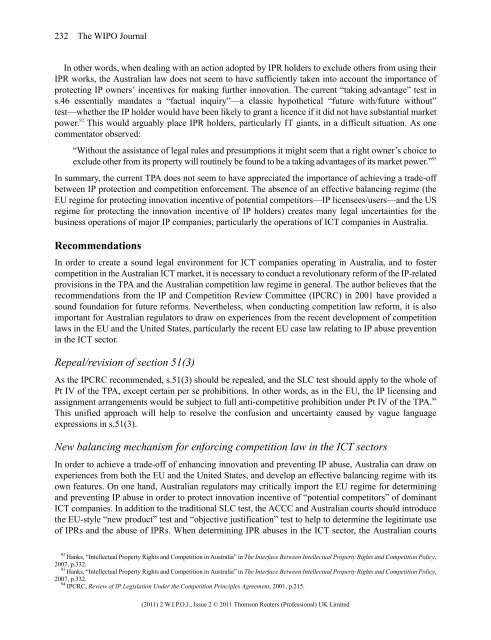WIPO Journal - World Intellectual Property Organization
WIPO Journal - World Intellectual Property Organization
WIPO Journal - World Intellectual Property Organization
You also want an ePaper? Increase the reach of your titles
YUMPU automatically turns print PDFs into web optimized ePapers that Google loves.
232 The <strong>WIPO</strong> <strong>Journal</strong><br />
In other words, when dealing with an action adopted by IPR holders to exclude others from using their<br />
IPR works, the Australian law does not seem to have sufficiently taken into account the importance of<br />
protecting IP owners’ incentives for making further innovation. The current “taking advantage” test in<br />
s.46 essentially mandates a “factual inquiry”—a classic hypothetical “future with/future without”<br />
test—whether the IP holder would have been likely to grant a licence if it did not have substantial market<br />
power. 92 This would arguably place IPR holders, particularly IT giants, in a difficult situation. As one<br />
commentator observed:<br />
“Without the assistance of legal rules and presumptions it might seem that a right owner’s choice to<br />
exclude other from its property will routinely be found to be a taking advantages of its market power.” 93<br />
In summary, the current TPA does not seem to have appreciated the importance of achieving a trade-off<br />
between IP protection and competition enforcement. The absence of an effective balancing regime (the<br />
EU regime for protecting innovation incentive of potential competitors—IP licensees/users—and the US<br />
regime for protecting the innovation incentive of IP holders) creates many legal uncertainties for the<br />
business operations of major IP companies, particularly the operations of ICT companies in Australia.<br />
Recommendations<br />
In order to create a sound legal environment for ICT companies operating in Australia, and to foster<br />
competition in the Australian ICT market, it is necessary to conduct a revolutionary reform of the IP-related<br />
provisions in the TPA and the Australian competition law regime in general. The author believes that the<br />
recommendations from the IP and Competition Review Committee (IPCRC) in 2001 have provided a<br />
sound foundation for future reforms. Nevertheless, when conducting competition law reform, it is also<br />
important for Australian regulators to draw on experiences from the recent development of competition<br />
laws in the EU and the United States, particularly the recent EU case law relating to IP abuse prevention<br />
in the ICT sector.<br />
Repeal/revision of section 51(3)<br />
As the IPCRC recommended, s.51(3) should be repealed, and the SLC test should apply to the whole of<br />
Pt IV of the TPA, except certain per se prohibitions. In other words, as in the EU, the IP licensing and<br />
assignment arrangements would be subject to full anti-competitive prohibition under Pt IV of the TPA. 94<br />
This unified approach will help to resolve the confusion and uncertainty caused by vague language<br />
expressions in s.51(3).<br />
New balancing mechanism for enforcing competition law in the ICT sectors<br />
In order to achieve a trade-off of enhancing innovation and preventing IP abuse, Australia can draw on<br />
experiences from both the EU and the United States, and develop an effective balancing regime with its<br />
own features. On one hand, Australian regulators may critically import the EU regime for determining<br />
and preventing IP abuse in order to protect innovation incentive of “potential competitors” of dominant<br />
ICT companies. In addition to the traditional SLC test, the ACCC and Australian courts should introduce<br />
the EU-style “new product” test and “objective justification” test to help to determine the legitimate use<br />
of IPRs and the abuse of IPRs. When determining IPR abuses in the ICT sector, the Australian courts<br />
92<br />
Hanks, “<strong>Intellectual</strong> <strong>Property</strong> Rights and Competition in Australia” in The Interface Between <strong>Intellectual</strong> <strong>Property</strong> Rights and Competition Policy,<br />
2007, p.332.<br />
93<br />
Hanks, “<strong>Intellectual</strong> <strong>Property</strong> Rights and Competition in Australia” in The Interface Between <strong>Intellectual</strong> <strong>Property</strong> Rights and Competition Policy,<br />
2007, p.332.<br />
94<br />
IPCRC, Review of IP Legislation Under the Competition Principles Agreement, 2001, p.215.<br />
(2011) 2 W.I.P.O.J., Issue 2 © 2011 Thomson Reuters (Professional) UK Limited

















